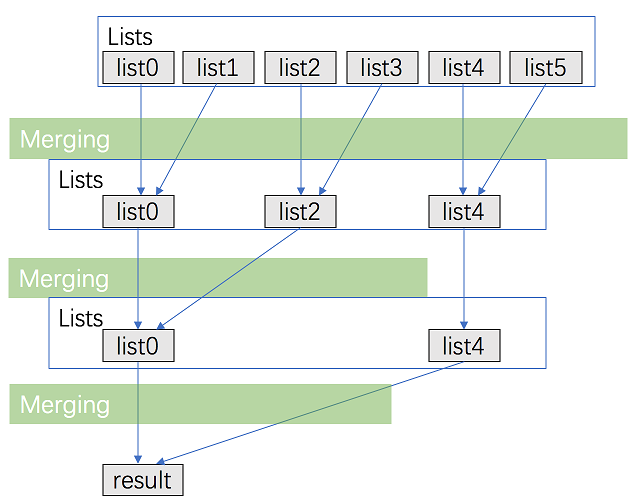题目描述
给你一个链表数组,每个链表都已经按升序排列。
请你将所有链表合并到一个升序链表中,返回合并后的链表。
示例 1:
输入:lists = [[1,4,5],[1,3,4],[2,6]]
输出:[1,1,2,3,4,4,5,6]
解释:链表数组如下: [ 1->4->5, 1->3->4, 2->6 ]
将它们合并到一个有序链表中得到。
1->1->2->3->4->4->5->6
示例 2:
输入:lists = []
输出:[]
示例 3:
输入:lists = [[]]
输出:[]
提示:
- k == lists.length
- 0 <= k <= 10^4
- 0 <= lists[i].length <= 500
- -10^4 <= lists[i][j] <= 10^4
- lists[i] 按 升序 排列
- lists[i].length 的总和不超过 10^4
个人解法
Java(顺序合并)
/*** Definition for singly-linked list.* public class ListNode {* int val;* ListNode next;* ListNode() {}* ListNode(int val) { this.val = val; }* ListNode(int val, ListNode next) { this.val = val; this.next = next; }* }*/class Solution {public ListNode mergeKLists(ListNode[] lists) {if (lists.length==0){return null;}ListNode l1=lists[0];for(int i=1;i< lists.length;i++){l1=mergeTwoLists(l1,lists[i]);}return l1;}public ListNode mergeTwoLists(ListNode l1, ListNode l2) {ListNode prehead = new ListNode(-1);ListNode prev = prehead;while (l1 != null && l2 != null) {if (l1.val <= l2.val) {prev.next = l1;l1 = l1.next;} else {prev.next = l2;l2 = l2.next;}prev = prev.next;}// 合并后 l1 和 l2 最多只有一个还未被合并完,我们直接将链表末尾指向未合并完的链表即可prev.next = l1 == null ? l2 : l1;return prehead.next;}}
JavaScript
/** @lc app=leetcode.cn id=23 lang=javascript** [23] 合并K个升序链表*/// @lc code=start/*** Definition for singly-linked list.* function ListNode(val, next) {* this.val = (val===undefined ? 0 : val)* this.next = (next===undefined ? null : next)* }*//*** @param {ListNode[]} lists* @return {ListNode}*/var mergeKLists = function (lists) {let listsArr = [];let flag = true;let root = new ListNode(0);let temp = root;const len = lists.lengthfor (let i = 0; i < len; i++) {if (lists[i]) {listsArr.push(lists[i]);}}while (flag) {const nowRootIndex = getMin(listsArr);if (!listsArr.length) {flag = false;break;}temp.next = new ListNode(listsArr[nowRootIndex].val);temp = temp.next;listsArr[nowRootIndex] = listsArr[nowRootIndex].next;if (listsArr[nowRootIndex] === null) {listsArr.splice(nowRootIndex, 1);}}return root.next;};function getMin(arr) {let minIndex = 0;const len = arr.length;for (let i = 1; i < len; i++) {if (arr[i] && arr[i].val < arr[minIndex].val) {minIndex = i;}}return minIndex;}// @lc code=end
其他解法
Java
分治法
class Solution {public ListNode mergeKLists(ListNode[] lists) {return merge(lists, 0, lists.length - 1);}public ListNode merge(ListNode[] lists, int l, int r) {if (l == r) {return lists[l];}if (l > r) {return null;}int mid = (l + r) >> 1;return mergeTwoLists(merge(lists, l, mid), merge(lists, mid + 1, r));}public ListNode mergeTwoLists(ListNode a, ListNode b) {if (a == null || b == null) {return a != null ? a : b;}ListNode head = new ListNode(0);ListNode tail = head, aPtr = a, bPtr = b;while (aPtr != null && bPtr != null) {if (aPtr.val < bPtr.val) {tail.next = aPtr;aPtr = aPtr.next;} else {tail.next = bPtr;bPtr = bPtr.next;}tail = tail.next;}tail.next = (aPtr != null ? aPtr : bPtr);return head.next;}}
优先队列
class Solution {class Status implements Comparable<Status> {int val;ListNode ptr;Status(int val, ListNode ptr) {this.val = val;this.ptr = ptr;}public int compareTo(Status status2) {return this.val - status2.val;}}PriorityQueue<Status> queue = new PriorityQueue<Status>();public ListNode mergeKLists(ListNode[] lists) {for (ListNode node: lists) {if (node != null) {queue.offer(new Status(node.val, node));}}ListNode head = new ListNode(0);ListNode tail = head;while (!queue.isEmpty()) {Status f = queue.poll();tail.next = f.ptr;tail = tail.next;if (f.ptr.next != null) {queue.offer(new Status(f.ptr.next.val, f.ptr.next));}}return head.next;}}
JavaScript
解法1——顺序合并
/*** @param {ListNode[]} lists* @return {ListNode}*/var mergeKLists = function (lists) {let temp = null;const len = lists.length;for (let i = 0; i < len; i++) {temp = mergin(temp, lists[i]);}return temp;};function mergin(list1, list2) {let node1 = list1;let node2 = list2;const root = new ListNode();let temp = root;while (node2 && node1) {if (node1.val <= node2.val) {temp.next = node1;node1 = node1.next;} else {temp.next = node2;node2 = node2.next;}temp = temp.next;}temp.next = node1 ? node1 : node2;return root.next;}
解法二——分治合并
考虑优化方法一,用分治的方法进行合并。
将 k 个链表配对并将同一对中的链表合并;
重复这一过程,直到我们得到了最终的有序链表。
/*** @param {ListNode[]} lists* @return {ListNode}*/var mergeKLists = function (lists) {if (!lists.length) {return null;}let len = lists.length;let arr = lists;while (len > 1) {let temp = null;let tempArr = [];let length = arr.length;for (let i = 0; i < length; i += 2) {if (i + 1 < length) {temp = mergin(arr[i], arr[i + 1]);tempArr.push(temp);} else {tempArr.push(arr[i]);}}arr = [...tempArr];len /= 2;}return arr[0];};function mergin(list1, list2) {let node1 = list1;let node2 = list2;const root = new ListNode();let temp = root;while (node2 && node1) {if (node1.val <= node2.val) {temp.next = node1;node1 = node1.next;} else {temp.next = node2;node2 = node2.next;}temp = temp.next;}temp.next = node1 ? node1 : node2;return root.next;}
class Solution {public ListNode mergeKLists(ListNode[] lists) {return merge(lists, 0, lists.length - 1);}public ListNode merge(ListNode[] lists, int l, int r) {if (l == r) {return lists[l];}if (l > r) {return null;}int mid = (l + r) >> 1;return mergeTwoLists(merge(lists, l, mid), merge(lists, mid + 1, r));}public ListNode mergeTwoLists(ListNode a, ListNode b) {if (a == null || b == null) {return a != null ? a : b;}ListNode head = new ListNode(0);ListNode tail = head, aPtr = a, bPtr = b;while (aPtr != null && bPtr != null) {if (aPtr.val < bPtr.val) {tail.next = aPtr;aPtr = aPtr.next;} else {tail.next = bPtr;bPtr = bPtr.next;}tail = tail.next;}tail.next = (aPtr != null ? aPtr : bPtr);return head.next;}}

